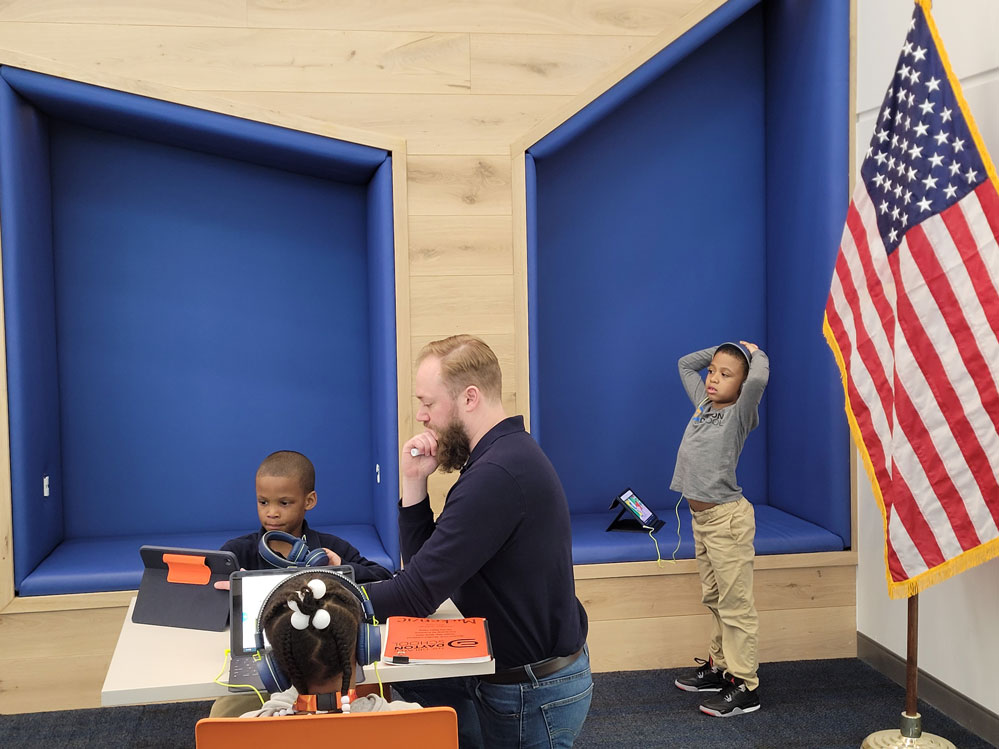Private School Just for Low-Income Kids Looks to Create Thriving Adults
The Greater Dayton School tries to build strong habits with scheduled toothbrushing, family-style meals and personalized lessons.

Get stories like this delivered straight to your inbox. Sign up for The 74 Newsletter
Fourth-grader Jeiona Odon sets the tray of food on a lunch table at The Greater Dayton School as fellow student Jacyn Diamond begins placing bowls on a revolving tray at the center.
The bowls of Caesar salad, spaghetti and chicken piccata are all made with fresh ingredients. And each bowl has tongs for the half dozen students and a teacher at each table to serve themselves as they rotate the wheel.
Two students at the Ohio school step to the front of the cafeteria to present what the school’s founding principal A.J. Stich calls the school’s “grace” — its goals for each student when they become adults.
One of the two students reads each line aloud, then pauses for the 102 kindergarten through fourth grade students in the cafeteria to repeat it:
Each day, I will work to achieve our Age 27 goals:
Being physically and mentally healthy,
Demonstrating character and integrity,
Preparing for a career and for financial independence,
And living my own definition of success.
May this food help our bodies;
We are thankful for the hands that made it and for the friends we share it with.
Family-style meals and the daily repetition of goals for their adult lives are one of several ways the Greater Dayton School sets itself apart from a typical school.
A private school that only accepts low income students, Greater Dayton is designed to help them with more than academics. Its goal is to let students set their own course in life and be financially independent and healthy as adults, not just graduate from high school or go to college.
Launched in the fall of 2022, the Greater Dayton School has income limits for all students, other than children of staff who may also attend. The school has a health clinic for students, extended school days until 5 p.m, two teachers in every classroom, individualized learning plans, and even schoolwide toothbrushing times.
Initially housed in a former Salvation Army administration building, the school hopes to grow to about 400 students from preschool to eighth grade. It’s still an experiment that’s too young to show a track record of success, but it already has a buzz around the city and drew Ohio’s Lt. governor to the grand opening of its new, much larger $50 million building this spring
“It’s really about the whole child, not just about academics,” said Larry Connor, a Dayton real estate developer whose company and foundation is funding most of the school. “Make no mistake, academics is important. But their physical health and their mental health is integral in obtaining good academic outcomes.”

Though the school is partially funded by state tuition vouchers of $6,165 per student, Greater Dayton spends $30,000 a year or more per student, with Connor and his company’s foundation covering the gap.
“Our objective is to build a model that can be replicated in cities throughout the United States,” Connor said. “We’re trying to take a really long term view, because every community in America has this type of need.”
Stich and other school leaders consulted successful schools across the country such as Meeting Street Academy in Charleston, S.C., Christina Seix Academy in Trenton, N.J., and the Waterside School in Stamford, Conn. as they built their plan to offer all the supports research says low-income kids need.

The school creates personal education plans for each student and lets them set much of their plan for each day — what the school calls their playlist — to give them ownership of their learning.
It limits classes to 20 students, then places two full-time teachers in each class. Students do much of their work online at their own pace, using programs from Zearn or Lexia while the teachers work with students individually or in small groups.
Students are grouped with a few grades in each classroom to intentionally mix ages. Eventually, after it adds grades, the school will group students in classrooms of Prek, K-2, 3-5 and 6-8.

“From an academic standpoint, I think it’s wonderful,” said Brittany Wylie, who teaches grades 2-4 as the school grows. “And it’s effective. In years past, if I had a fifth grade classroom, the actual academic level of those students could range anywhere from kindergarten through sixth grade, but I was expected to teach them all just fifth grade curriculum, whether they actually grasp it or not. Here, I feel like I’m actually seeing students understand and digest and then be able to move on.”
Greater Dayton also supports students and families with after school activities until 5 p.m. The extra time solves child care needs of working parents, while also helping close the gap between what suburban and affluent students receive in enrichment activities and what lower income families can afford.
While some students build models of rockets or the Taj Mahal with Legos, others run a store where others buy items with “money” they earn by meeting school goals. Mark Kreider, the school’s financial literacy teacher, oversees the store after spending the day teaching even the youngest students the basics of business and savings.

“There’s no such thing as too early,” Kreider said. “I really think that this idea of building wealth, versus just surviving is such a critical concept for our kids,” said Kreider. “We talk about financial independence…because if you’re in this cycle of paycheck to paycheck, drowning in debt, your options are just incredibly narrow.”
“I don’t know what our kids are going to do when they get older,” he added. “But I just want them to have options. Will they all own a small business? Probably not. But they should at least know how and know how to think about it. It’s almost like a worldview, a perspective. Hey, that’s the dream.”

Students also earn freedom with good behavior, earning the right to work outside the classroom, often on the giant open staircase and terrace with couches that overlook the cafeteria.
Student health is a major part of the school’s mission. Students have more than an hour of physical education each day. Meals are at least 80 percent whole foods, with minimal processing or sugar, other than a dessert only on Fridays.

The school also has created a medical and dental office in the school, run by Dayton Children’s Hospital, so students can receive care as part of the school day, without parents having to take them out of school. Because Medicaid eligibility is a requirement for most students to enroll, the care is already covered.
“When it’s time for kids to go to the doctor, go to the dentist, they walk downstairs, and then they go back to class,” Stitch said.
The school even makes brushing teeth a daily habit by having all students head to the bathrooms at scheduled times to brush, as teachers watch to be sure they do it right.
Mental health is also a priority, particularly since students can come from families facing financial and other challenges. The school has a mental health counselor now for its 102 students and plans to add another as the school grows.

How much impact the school is having is still unclear. Like other Ohio private schools, its students don’t take Ohio’s state tests. Using NWEA diagnostic test scores and NWEA’s own model for comparing scores to Ohio state tests, the school estimates that students are gaining academically faster than state averages and that 72 percent of its students score as proficient, compared to 45 percent of low-income students in Dayton’s county.
Wylie, who previously taught in the high-poverty Youngstown schools, said the school setting high standards and then rewarding students who meet them creates an atmosphere of accountability and trust that shows students how to thrive.
“We really believe that they can do anything they set their mind to, that they will be successful, and that they are valuable,” she said. “My personal belief is that students from any background, if they haven’t had an example modeled for them, they don’t know any better. They just need the opportunity to be shown.”
Get stories like these delivered straight to your inbox. Sign up for The 74 Newsletter

;)
